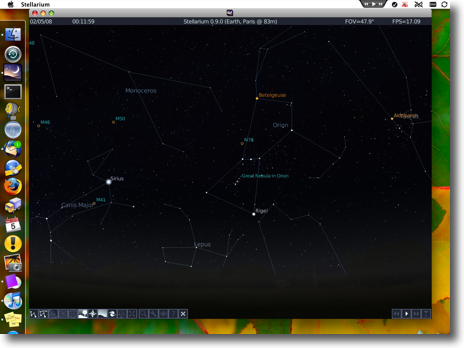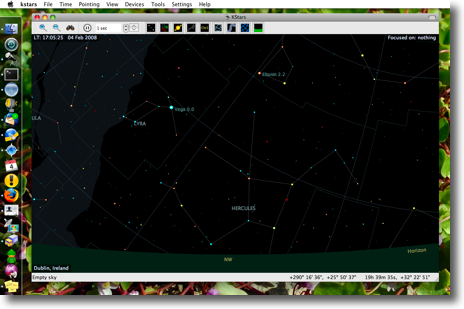Feb
5
Free Astronomy Software on the Mac Revisited
Filed Under Science & Astronomy, Computers & Tech on February 5, 2008 at 2:43 am
The last time I posted on the state of play for free Astronomy software for the Mac things weren’t looking so good. At that time your best option was to build the Linux program KStars from source using Fink. A long, complicated, and rather daunting install for anyone who’s not a Unix geek. I’m happy to report that things have improved a lot since then. There’s now a choice of three apps and you don’t have to compile any from source (unless you want to).
[tags]astronomy, OS X, Stellarium, Cartes du Ciel, KStars[/tags]
I’ll start with the best app for beginners, this is a true cross-platform app represented on Linux, Windows and the Mac, Stellarium. When it first came to the Mac it was buggy as hell. My first experiences of it when I’d just gotten my MacBook Pro were so terrible I didn’t try it again until a few weeks ago. My how things have changed! Mac support is now flawless and it’s quick and looks really pretty. This is the perfect program for beginners and for just seeing at a glance what’s where in the sky at any time. The interface is also not at all Mac-like and a little confusing at first. Thankfully you just have to hover over the buttons to see what they do so you’ll be working away quick enough. Although it’s not going to be sufficient for the more advanced amateur but it’s still a program I think everyone interested in Astronomy should have on their computer.
Back when I was a windows user I loved Cartes du Ciel. There’s now a beta version available for Linux and the Mac, though the pre-compiled version available on the site is for Intel Macs only. If you have a PowerPC Mac the source is available if you’re brave enough to have a go at compiling it yourself. There is a slight complication in that this app has a real identity crisis. The folder it’s in is called ‘Cartes du Ciel’, the file is skychart.app and when its running it calls itself ‘cdc’ in the menubar. It is also beta software and shows it a little. I have to re-enter my location each time I load it for example. It’s still a little rough around the edges but it does work and I have a feeling this will be an app to watch for in the future. It’s also aimed at the more advanced end of the market which Stellarium doesn’t cater for very well.
Finally, staying at the more advanced end of the market, KStars is still a very good option, a better option indeed than it used to be. You don’t HAVE to compile it anymore, though, if you want to that’s gotten easier too. To get a native OS X version of KStars that doesn’t run under X11 and doesn’t need to be compiled you can install the kdeedu package (and its listed dependencies) from the KDE 4 for OS X project. The screen-shot below shows this version of KStars running under OS X 10.5 Leopard on my G5 PowerMac.
There is a downside to this approach though, if you download the full KDE distribution it comes to over 2GB! That’s a big download! You don’t have to do that, you can grab the individual packages but that’s more complicated and you have to manage the dependencies yourself. If you grab the lot you get an installer (kde.mpkg) so you don’t have to worry about the dependencies yourself. Also, this download is only available over BitTorrent. If all that scares you off then installing MacPorts and running the single terminal command:
sudo port install kdeedu3
Will allow you to build KStars from source. This comes with two downsides, firstly, it takes a while, secondly you’ll have to launch the program from the terminal (simply issue the command kstars& and ignore all the scary text output), thirdly it runs under X11 so you’ll need that installed, and finally you need the developer tools installed too.
So, all in all a big improvement since my last post on the subject.










Thank you for your time and effort. It is comforting to know there are people who will share knowledge and technology…
I am enjoying Stellarium very mucho
it is a good software
also look at xephem.
d
Can you tell me if there is a freeware (I am a real beginner) that can show the aspect of sky through time? For example, what people saw in Rome in 2000BC?
Thanks?
Or some instructions on how to calculate it?
thanks
Hi Lucia,
The first app I recommended (Cartes du Ciel/Skycharts) has been updated to version 3 now, which works just fine on Windows, Mac & PC, and lets you set the date to any arbitrary time of your choosing. You can download it here: http://www.ap-i.net/skychart/en/download
Regards,
Bart.
Great summary, thanks a lot! I use Stellarium to help me study for my constellations exam in astronomy.